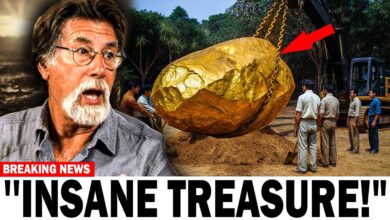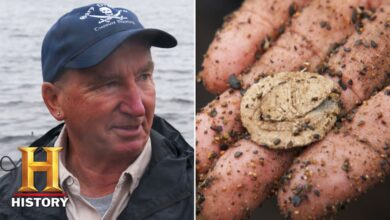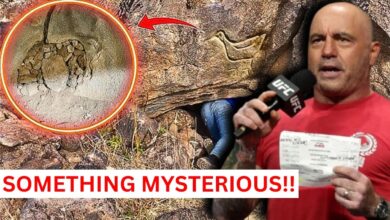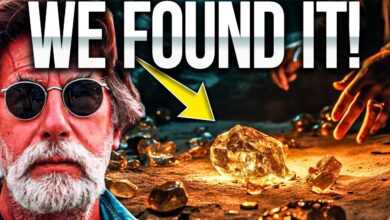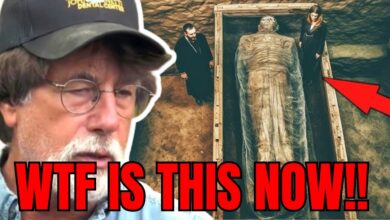Rick Lagina: ”We Have Never Seen This Before”
Rick Lagina: ''We Have Never Seen This Before''

Shrouded in mystique and legend, Oak Island continues to yield its treasures. Not just gold or jewels, but fragments of history waiting to be pieced together. Recently, they have uncovered four ancient coins in the area, with some traced back to Roman civilization.
Season 11 brings a groundbreaking discovery on lot 5, an area already known for its ancient artifacts, but this time, the findings point towards a surprising connection between the Templar Knights and the French. Join us as we go through the 17th century French relic discovered recently in The Curse of Oak Island season 11.
17th century French relic. Rick Lgina and his colleague Gary Drayton, experienced detectives in the island secrets, are on a trail. Lot 5’s reputation as a gateway to the past is further strengthened by these numismatic wonders, three of which are believed to be around 500 AD–300.
However, that excitement doesn’t stop there. They meet an abnormality when they get deeper: a strap with a bow tie design. He holds the specimen, examines it carefully, and reveals that the strap is French. It is ornamental and was once placed on wooden chests, with earlier French influence implied.
This revelation opens Pandora’s box of possibilities. Would this then prove that the French were there before the 17th century? The connection gets even stronger when Rick says the lead cross was found to have come from the south of France. The puzzle pieces are coming together, pointing to an ancient French connection no one would have ever expected.
Zena Halburn’s map is another controversial document that only fuels the fire. It is a map supposedly drawn by the Knights Templar between the 12th and 14th centuries showing a possibility of a hatch on Oak Island. While controversial, Zena’s theory correlates with these new findings, implying that the Templars could have visited the island on multiple occasions to hide their secrets.
The deeper the team digs, the more iron artifacts come upon them—fasteners, tools, and even a thick-looking chisel-shaped object. Each of these findings bears the stamp of age, supporting the theory that there was a pre–money pit presence. The lot 5 journey is still ongoing.
For Rick, it is a call to action to go back there and dig more. Whenever the archaeologists reveal a discovery, the curtain of Oak Island’s ancient past lifts, telling tales of French conspiracy and, of course, the Knights Templar, Oval Chain, and Oshoe.
In the last season, Gary Drayton and treasure hunter Michael John found something groundbreaking when exploring Lot 8. Lot 8 had become an important area of the team’s exploration since they started noticing significant metallic anomalies while using their ground penetrating radar at a depth of 20 ft.
Gary Drayton observed a layer of rocks across the area that indicated human activities. Further evidence is unveiled in the form of a mysterious stone-paved feature, a sizable boulder, and a semi-precious garnet gemstone that 32nd degree Freemason Scott Clark believes could be linked to the Knights Templar and the Ark of the Covenant.
While Rick, Marty, and Craig waited for governmental permission to excavate where the anomaly was located, Gary and Michael set out to uncover clues that would help prove Scott Clark’s theory. Their initial target scene produces a signal on the metal detector, hinting that they might have found historical artifacts.
After digging, they found an old oval chain link that was probably used to transport a large chest. They continue exploring and then stumble on a deep-seated ox shoe, which adds to the mystery. The ox shoe was still in good condition and excellent, and it also pointed out that heavy cargo was carried along these paths.
These discoveries align with past discoveries from over 2 years when the team uncovered ancient stone pathways, ox shoes, and evidence of large-scale cargo operations on the island. The team believes a major operation was carried out in lot 8, and this theory also aligns with Scott Clark’s theory of Knights Templar activities in the area and the possible concealment of religious artifacts.
These connections become stronger as more discoveries are revealed in lot 5.
The mystery of lot 5, the last frontier of the island landscape, opens up a new season of The Curse of Oak Island. Unperturbed by the murmuring of infertility, fueled with unfailing faith and the murmuring of stories yet to be told, the Legina brothers go on a venture.
For decades, their innovative techniques, hard wrought by toil, cut through the cloak of invisibility to unearth a horde of forgotten currency pieces, each telling a yarn about bygone empires and buried mysteries. This numismatic drama begins with discovering four coins nestled close to each other.
The fact that there is so much concentration in such a small space creates a lot of speculations that have long shadows of possibility. Was this by design, a mere accident of history, or a silent testimony of a greater treasure awaiting to be revealed?
The Knights Templar air echoes, merging legends with the rusty metal discs. However, after discovering a prehistoric lead token for bartering with the scalloped edges, mirroring the Smith’s Cove lead cross in 2017, the plot thickens. The wind carries the whispers of the 14th century and weaves an intricate tapestry of vanished civilizations and forgotten bonds.
Are these innocent objects—which can potentially be the Rosetta Stone of the island’s secrets—the whispers of Templar inscribed in the lead? The intriguing aspect heightens as the exquisite patterns and symbols of the coins slowly emerge from the shadows.
Sandy Campbell, a numismatic giant with over 40 years of experience, strides upon the podium. Her gaze is a microscope that sees through the whispers of time. Her tools are metallurgy, iconography, paleography, and provenance analysis. Every scratch on the metal is a battlefield in which history is unfolded.
Sandy’s quest goes beyond just identifying the coins. She wants to discover where the coins came from, the story of their journey through time, and the tales of civilizations that they convey. Were they just pieces of cold currency exchanged in secret and hushed conversations at night? Or were they just a measure of power?
Each of these coins is like a tiny time capsule that can rewrite history and change the narrative about Oak Island, one piece at a time. However, the plot takes another turn, disrupting the European narrative. Sandy notices one coin as Indian, an offspring of the 6th to 8th century AD.
This unexpected guest from the east comes in to disrupt the comforting familiarity, adding color to the numismatic tapestry. The collection includes English plunder, Spanish treasure, and even a glint of Chinese gold. The island mystery is the secret behind all of this.
And then the ultimate revelation that would send Midas screaming. Sandy discovers a piece of gold within one of the coins, a real Roman blaze. The Roman coin count doubles and the mystery only gets worse. Out of the shadows comes the face of a man with a pointed chin and a keen nose—a mute witness to the centuries that have passed.
Another coin which depicts two figures hugging each other tells us about pre-Christian times and is evidence of the island’s antiquity. The biggest coin ever found on Oak Island is an earth-shattering discovery once considered barren. Lot 5 has bloomed into a numismatic garden of Eden full of forbidden fruits with every coin having a historical significance.
These metallic time capsules hold within them the whispers of civilizations, the echoes of vanished journeys, and even the secrets of time. However, the Legina brothers remain adamant in their search for answers with the help of the wisdom of scholars such as Sandy Campbell. Lot 5 remains a testimony to the undeterred quest for knowledge, the battle of history, and the commitment that Oak Island, the mysterious siren of the north, still conceals mysteries yet to be unraveled.
The last chapter of the numismatic story has yet to be written. But with every find, the murmur of the past gets stronger, urging us farther and farther into the heart of the mystery.
As archaeologists stumble upon a metallic object in lot 5, the air seems exciting. This huge artifact buried deep within the earth raises speculations. Marty Lginina imagines it is the lost lid of the cellar door, the mysterious money pit. The team relocated the artifact to the interpretive center to reveal its secrets.
Emma Culligan, archometallurgist, uses her CT scanning to discover the object’s true shape, concealed just below the hard surface of the ground. However, according to Lared Nan, the analysis suggests it is only a simple river spike with multiple uses. The mystery continues as the metal shortage of manganese worsens.
Interestingly, having studied artifacts from Sir William Phips’s birthplace, Nan makes an intriguing correlation. Phips, one of the prominent characters in Oak Island legend, is believed to have hidden the island treasure he had gotten from the plunder of a Spanish ship.
As Nan and Culligan explain, the river spike does not match anything found in previous excavations, but is very similar to their findings from Phips’s home region. This discovery sparks a new line of inquiry that stitches together previously unrelated threads. Can this simple river spike be part of the Phips puzzle? The money pit. Is it the answer to the mystery? Only time will tell and further investigation will reveal.
But one thing is certain: Oak Island continues singing its mysterious tales as each revelation becomes a new chapter in the island’s story.
The mysterious island of Lot 5 reveals intricate labyrinths of underground tunnels telling stories of long-forgotten civilizations and buried secrets. The Lginina brothers get hope when they use sonic drills to pierce the earth about 10 ft and find a soft zone that is as expected with what the previous sonar readings indicated. Might this be the elusive door to this fabled treasure?
On the other hand, geologist Terry Mat begins the first sonic drilling operation of the year adjacent to the garden shaft while archaeological teams work meticulously in lot 5. The excitement starts bursting out with borehole B5N13 reaching a depth of 109 ft and encountering a soft area, a geology oddity, indicating possible underground chambers.
This may indicate that the money pit could be near the borehole, according to historians Charles Barkhouse and Alec Laginina. The story takes a new twist as Charles and surveyor Steven Guptal reveal that B5N13 is just 9 miles from where other precious minerals were discovered.
Despite this, a disappointing recovery of limestone and hard shale at 36 m dampens their optimism about the borehole’s location. Yet, a crucial discovery emerges from borehole DN12 within the treasure zone. A collapsed chamber lowered down is confirmed by Earth drawn at 97.5 ft.
Again, as if orchestrated by a good storyteller, lot 5 reveals another stunning discovery, a network of interconnected tunnels that burrows under the island. Intricate and a clear sign of deliberate human intervention, it is a painting of a once purposeful civilization that explored the island’s depths.
In addition, diver Tony Samson’s underwater exploration yields logs of wood and blue painted pottery, indicating ancient shipwrecks or lost settlements. This further makes the island’s already confusing story mysterious.
Additionally, historian Gary Halpern looks into the Knights Templar, an order of medieval knights associated with tremendous wealth and secrecy. His exploration hints at a possible Templar expedition to Oak Island with rich loot. Similarities between Halpern’s Templar’s Treasure and the buried riches of Oak Island make the theory gain ground.
Additionally, the discovery of extremely well-preserved Roman coins thought to be over 2,000 years old makes the story even more interesting. Furthermore, an English brick engraved with 1347 and similar artifacts indicate the Templar’s possible participation.
Marty Lginina, a veteran of Oak Island research, notes some remarkable similarities between the discoveries and a particular region in Portugal known for its ancient Templar associations. This impressive evidence forms a riveting fabric where each strand leads to the final revelation of the elusive Oak Island mystery.
The intersection of Roman coins, Halpern’s theories, and the rumblings of the Knights Templar calls for further investigation and scrutiny.
Days after the New Year’s conference, the Lega Brothers archaeological team, led by Leair Nan, descended upon Lot 5, their gazes fixed on the intriguing circular depressions. While most alterations were attributed to the island’s final caretaker, Robert Young, whispers of a grander multi-century endeavor lingered in the air.
Their quest centered on unearthing a foundation wall, hinting at a pre-1769 structure, a testament to a bygone era. As Jaime Kuba and Fiona Steel meticulously sifted through the soil, their shovels struck a curious treasure: fragments of red earthenware.
Redware, an alternative to stoneware, once thrived across Europe and North America, its humble presence spanning the 17th and 18th centuries. Yet, this particular red earthenware held a unique charm. Its striking purple-black glaze sent shivers of wonder down Nan’s spine.
Further excavation revealed a curious mix—coarse earthenware alongside redware. This disparity and the lack of clear historical context fueled speculation of an early origin, perhaps even predating the island’s infamous money pit. Nan, seasoned in the ways of ancient pottery, remarked on its remarkable resilience, barely changing across centuries.
The question loomed: when was the money pit discovered? Could these fragments be whispers of prospectors who roamed the island long before the legendary pit’s emergence? Ever the seeker of truth, Rick Legina stood captivated, his mind ablaze with possibilities.
Meanwhile, Jack Begley and Alex Legina, joined by Tony Samson and Ken Dbor, embarked on a different quest on the northern expanse of Oak Island. Their target: a watery expanse rumored to hold the remnants of a man-made structure. While recovering the structure might be a lost cause, their mission was to gather evidence, a vital step towards securing an excavation permit.
As Samson’s sonar pierced the depths, a tableau of forgotten artifacts emerged from the murky embrace. A hand-carved wooden plank a foot long hinted at a dam, its silent echoes whispering of a bygone era. Shattered pottery adorned with forgotten blue designs lay scattered like fallen stars. A clay sailor’s pipe worn smooth by time spoke of lives lived and stories untold.
And then a glimmer of silver—a coin, its design faintly recognizable—a compelling link between land and sea. Did these sunken whispers speak of a shipwreck, its cargo scattered beneath the waves? Or were they mere possessions of the island’s early settlers, echoing the mysteries buried within the money pit?
Questions swirled unanswered for now. But the Lega brothers remained undeterred. Their optimism, a beacon in the face of uncertainty, fueled their conviction that Oak Island’s secrets would soon yield to their relentless pursuit.
The upcoming season of The Curse of Oak Island promises to be a thrilling odyssey, a voyage into the heart of the unknown. Never before have the Lega Brothers stood closer to unraveling the island’s enigma, to unlocking the treasures hidden within its depths.
The whispers of Oak Island grow louder, beckoning us deeper into its labyrinth and history, where time seems to bend and secrets lie in wait, ready to be revealed. So fasten your seat belts, dear reader, for the journey ahead promises breathtaking discovery and awe-inspiring revelation.
This is just a glimpse into the captivating tapestry of Oak Island, woven with threads of red earthenware, sunken whispers, and unwavering hope.
Let’s hear your thoughts in the comments about what you expect this season of Oak Island to give below. Also, don’t forget to like this video and subscribe to the channel for more. See you soon.




